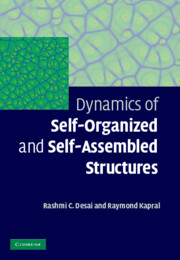Book contents
- Frontmatter
- Contents
- preface
- 1 Self-organized and self-assembled structures
- 2 Order parameter, free energy, and phase transitions
- 3 Free energy functional
- 4 Phase separation kinetics
- 5 Langevin model for nonconserved order parameter systems
- 6 Langevin model for conserved order parameter systems
- 7 Interface dynamics at late times
- 8 Domain growth and structure factor for model B
- 9 Order parameter correlation function
- 10 Vector order parameter and topological defects
- 11 Liquid crystals
- 12 Lifshitz–Slyozov–Wagner theory
- 13 Systems with long-range repulsive interactions
- 14 Kinetics of systems with competing interactions
- 15 Competing interactions and defect dynamics
- 16 Diffusively rough interfaces
- 17 Morphological instability in solid films
- 18 Propagating chemical fronts
- 19 Transverse front instabilities
- 20 Cubic autocatalytic fronts
- 21 Competing interactions and front repulsion
- 22 Labyrinthine patterns in chemical systems
- 23 Turing patterns
- 24 Excitable media
- 25 Oscillatory media and complex Ginzburg–Landau equation
- 26 Spiral waves and defect turbulence
- 27 Complex oscillatory and chaotic media
- 28 Resonantly forced oscillatory media
- 29 Nonequilibrium patterns in laser-induced melting
- 30 Reaction dynamics and phase segregation
- 31 Active materials
- References
- Index
31 - Active materials
Published online by Cambridge University Press: 10 February 2010
- Frontmatter
- Contents
- preface
- 1 Self-organized and self-assembled structures
- 2 Order parameter, free energy, and phase transitions
- 3 Free energy functional
- 4 Phase separation kinetics
- 5 Langevin model for nonconserved order parameter systems
- 6 Langevin model for conserved order parameter systems
- 7 Interface dynamics at late times
- 8 Domain growth and structure factor for model B
- 9 Order parameter correlation function
- 10 Vector order parameter and topological defects
- 11 Liquid crystals
- 12 Lifshitz–Slyozov–Wagner theory
- 13 Systems with long-range repulsive interactions
- 14 Kinetics of systems with competing interactions
- 15 Competing interactions and defect dynamics
- 16 Diffusively rough interfaces
- 17 Morphological instability in solid films
- 18 Propagating chemical fronts
- 19 Transverse front instabilities
- 20 Cubic autocatalytic fronts
- 21 Competing interactions and front repulsion
- 22 Labyrinthine patterns in chemical systems
- 23 Turing patterns
- 24 Excitable media
- 25 Oscillatory media and complex Ginzburg–Landau equation
- 26 Spiral waves and defect turbulence
- 27 Complex oscillatory and chaotic media
- 28 Resonantly forced oscillatory media
- 29 Nonequilibrium patterns in laser-induced melting
- 30 Reaction dynamics and phase segregation
- 31 Active materials
- References
- Index
Summary
Self-organization and self-assembly take different forms, and their description involves the consideration of different principles when the elements comprising the system undergo active motion. The active motion may arise either because the elements are self-propelled or because external forces or fluxes are applied to the system to induce motion. Biology provides many examples of such active media. Microorganisms such as Escherichia coli move by using molecular motors to drive flagella that propel the organism. The amoeba Dictyostelium discoideum moves by using pseudopods that change shape through actin polymerization and depolymerization processes. Large numbers of such active agents often display collective behavior: for example, Dictyostelium discoideum colonies form streaming patterns, and rippling patterns are seen in myxobacteria such as Myxococcus xanthus. Myxobacteria patterns have been modeled using reaction–diffusion-like descriptions (Börner et al., 2002; Igoshin and Oster, 2004). Flocking behavior is also exhibited by birds, fish, mammals, and a variety of microorganisms (Reynolds, 1987). The spatial patterns seen in these systems span a large range of length scales, from kilometers for herds of wildebeest to micrometers for colonies of the amoeba Dictyostelium discoideum.
Often particle-based models are employed to describe the nonequilibrium dynamics of active media. Studies based on such models show that collective motion arises as a result of the emergence of orientational long-range order in a system with many degrees of freedom. Simple discrete models are able to capture many of the essential features of the collective behavior (Vicsek et al., 1995; Grégoire et al., 2003). Figure 31.1 shows configurations depicting cohesive flocks obtained from simulations of a discrete model.
Information
- Type
- Chapter
- Information
- Dynamics of Self-Organized and Self-Assembled Structures , pp. 299 - 306Publisher: Cambridge University PressPrint publication year: 2009
